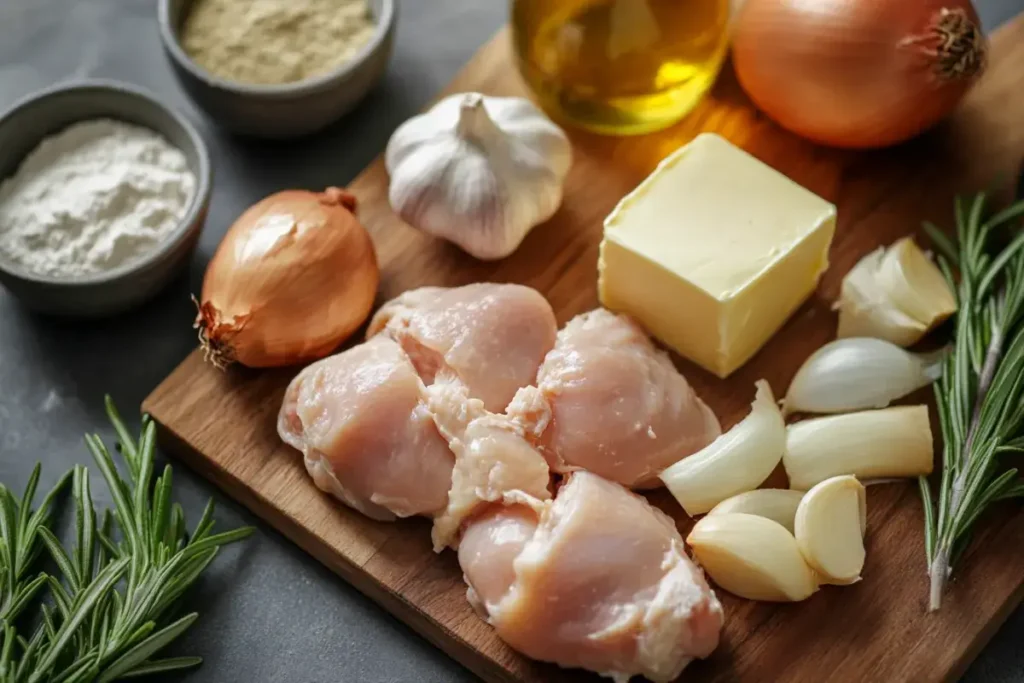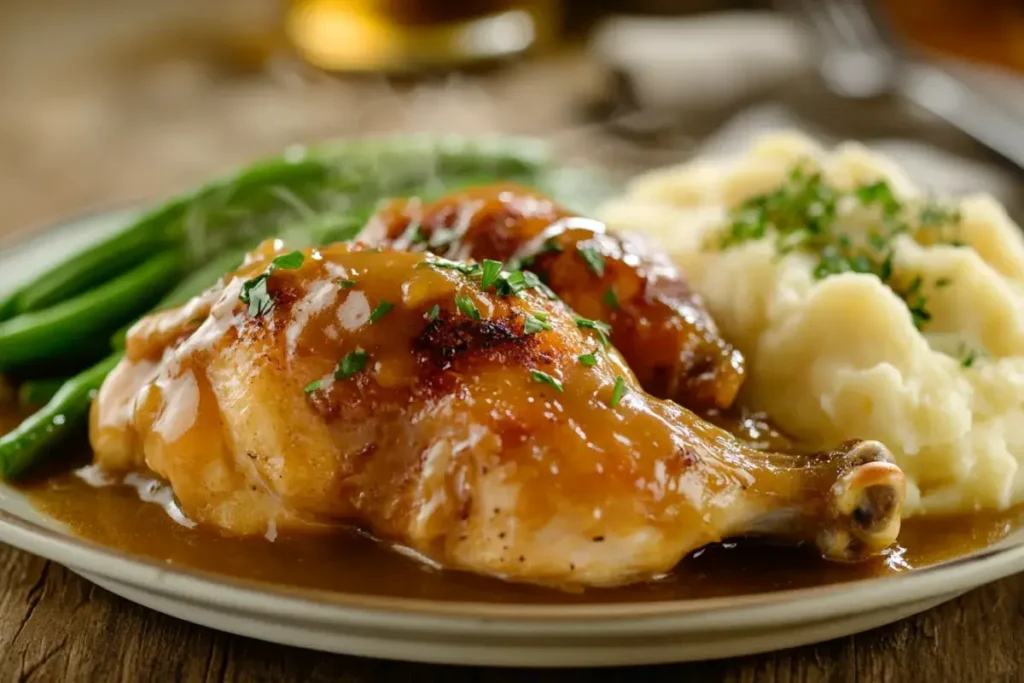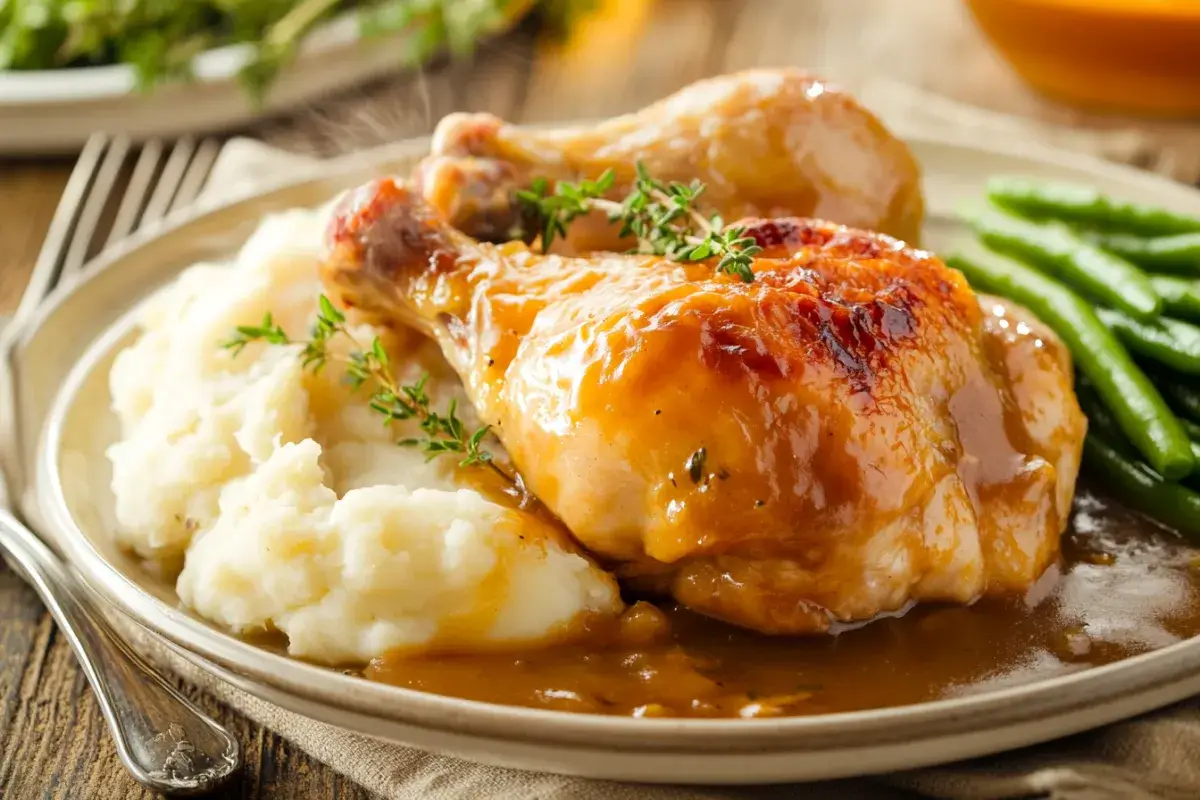Nothing beats a comforting plate of chicken and gravy. Whether you’re cooking for a family dinner or simply craving a hearty meal, this dish always hits the spot. Not only is it simple to make, but it’s also versatile and budget-friendly. With tender chicken smothered in a rich, flavorful gravy, it’s easy to see why this recipe is a beloved staple in many homes. Let’s dive into everything you need to know to perfect this classic comfort food.
Ingredients for Chicken and Gravy Recipe
Before we jump into the cooking process, let’s talk about the ingredients. The great thing about chicken and gravy recipe is that it doesn’t require any fancy items. Here’s a list of everything you need:
- Chicken: You can use chicken breasts, thighs, or even a whole chicken depending on what you have on hand.
- Butter: Essential for creating a rich base for the gravy.
- All-purpose flour: To thicken the gravy.
- Chicken broth: The foundation for your gravy’s flavor.
- Seasonings: Salt, pepper, and herbs like thyme or rosemary.
- Optional additions: Mushrooms, garlic, and cream to elevate the flavor profile.
These basic ingredients are likely already in your kitchen. You can also add herbs or vegetables to customize the dish to your liking.
Choosing the Right Chicken for Your Recipe
Picking the right cut of chicken can make a big difference in how your dish turns out. But don’t worry, this recipe works well with a variety of cuts.
- Chicken breasts: Perfect for a leaner option, though they can dry out if overcooked.
- Chicken thighs: Known for being juicier and more flavorful, ideal for a rich, tender bite.
- Whole chicken: If you want to go all out, cooking a whole chicken creates an impressive centerpiece for your meal.

Bone-in vs. Boneless Chicken
Using bone-in chicken can add an extra depth of flavor to your gravy, as the bones release juices during cooking. On the other hand, boneless chicken is easier to work with and quicker to cook. Either option works, so it’s all about what you prefer. Boneless chicken is also a great option for recipes like buffalo chicken wraps, which are easier to prepare with tender, bite-sized pieces of chicken.
Organic vs. Conventional Chicken
While organic chicken is often touted as the healthier choice due to fewer additives, conventional chicken works just as well for this dish. Whichever you choose, make sure it’s fresh for the best results. If you’re curious about selecting the right cuts, you can explore a guide on the types of chicken cuts to help you decide.
How to Prepare the Chicken for Cooking
Now that you’ve selected your chicken, it’s time to prepare it for cooking. Proper preparation ensures your chicken stays juicy and flavorful.
- Washing: Rinse your chicken under cold water to clean it.
- Patting dry: Use paper towels to remove excess moisture, which will help create a golden crust when you brown the chicken.
- Trimming: Cut off any excess fat or skin to ensure even cooking.
If you’re looking for extra flavor, marinating the chicken before cooking is a great option. Even a quick 30-minute soak in herbs, garlic, and a splash of olive oil can work wonders.
Step-by-Step Instructions for Cooking Chicken
1. Browning the Chicken
Browning your chicken is crucial for developing rich flavor in this chicken and gravy recipe. Follow these steps for perfectly browned chicken:
- Heat a pan over medium heat and add some butter or oil.
- Place the chicken in the pan, skin-side down if you’re using skin-on cuts.
- Cook for 5-7 minutes per side, until golden brown.
This searing step not only locks in the juices but also creates tasty browned bits at the bottom of the pan, which will be essential for your gravy.
2. Checking Internal Temperature
When cooking chicken, it’s important to ensure that it reaches an internal temperature of 165°F (75°C) to ensure it’s fully cooked. To ensure the chicken is cooked through, use a meat thermometer to check the internal temperature. If you don’t have one, you can verify doneness by cutting into the thickest section and confirming that the juices run clear.
3. Cooking Methods
Depending on your preferences and time, you can cook the chicken in a variety of ways:
- Stove-top: This method gives you the best control over browning and keeps all the flavors in one pot.
- Oven: After browning the chicken on the stove, finish cooking it in the oven for a more hands-off approach.
- Slow cooker: Ideal for tender, fall-off-the-bone chicken. Just brown the chicken first and then transfer it to the slow cooker with some broth.
Whichever method you choose, the goal is to cook the chicken evenly while keeping it moist. If you’re pressed for time, a quick sear on the stove followed by finishing in the oven is a great option.
How to Make Perfect Gravy for Chicken
The gravy is what ties this dish together, and getting it right is easier than you think. The key lies in using the same pan where you cooked the chicken to capture all those delicious browned bits (fond).
Basic Ingredients for Gravy
- Butter: Adds richness to your gravy.
- Flour: Helps thicken the sauce.
- Chicken broth: Brings depth to the gravy, especially when combined with the pan drippings.
- Pan drippings: These provide all the flavor from the browned chicken.
Step-by-Step Gravy Instructions
- Remove the chicken from the pan and set it aside.
- Melt butter in the same pan, then whisk in the flour to form a roux.
- For tips on making a perfect roux, you can check out this guide on making a roux.
- Slowly add chicken broth while whisking continuously to prevent lumps.
- Simmer the gravy until it thickens, usually around 5-7 minutes.
Preventing Lumps in Gravy
The key to smooth, lump-free gravy is whisking constantly as you add the broth. If lumps do form, simply strain the gravy before serving.
Adjusting the Thickness
- If your gravy is too thin, whisk in a bit more flour or let it simmer longer.
- If it’s too thick, you can thin it out by adding more chicken broth or even water.
For added flavor, consider incorporating herbs like thyme or a splash of cream for extra richness.
Common Mistakes to Avoid When Making Chicken and Gravy
Even seasoned cooks make mistakes, but avoiding these common errors will ensure your chicken and gravy turns out perfect every time.
- Overcooking the Chicken: This can leave your chicken dry and tough. Always check the internal temperature.
- Watery Gravy: This happens when there’s too much liquid or not enough flour. Fix this by simmering longer or adding a bit more flour.
- Undercooked Roux: If you don’t cook your flour and butter mixture long enough, your gravy can taste raw. Make sure the roux turns a light golden color before adding the broth.
Variations of Chicken and Gravy
One of the best things about the chicken and gravy recipe is how adaptable it is. Depending on your tastes or dietary needs, there are several ways to tweak the recipe.
Classic Southern Chicken and Gravy
This variation leans heavily on the rich, deep flavors of butter and a slow-cooked roux. Often served over mashed potatoes or biscuits, it’s a staple in Southern cuisine.
- Use chicken thighs for a more tender and flavorful dish.
- Add a touch of garlic and onions to the gravy for a deeper flavor.
Creamy Chicken and Mushroom Gravy
For those who love a creamy texture, this variation is a great choice.
- Sauté some mushrooms along with the chicken to add an earthy richness.
- Replace part of the broth with cream for a velvety finish.
Healthy Version: Low-Fat Chicken and Gravy
If you’re watching your fat intake but don’t want to miss out on flavor, this version has you covered.
- Use skinless chicken breasts to reduce fat content.
- Replace butter with olive oil or a light cooking spray.
- Use cornstarch instead of flour to thicken the gravy without adding extra calories.
Gluten-Free and Dairy-Free Gravy Options
For those with dietary restrictions, you can still enjoy this comfort dish by making a few substitutions.
- You can thicken your recipe by using either gluten-free flour or cornstarch as an alternative thickener.
- Substitute butter with a non-dairy option such as margarine or coconut oil.
- Opt for almond milk or another dairy-free substitute to make the gravy creamy.
What to Serve with Chicken and Gravy
The chicken and gravy recipe is a versatile dish that pairs well with a variety of sides. Here are a few classic pairings that enhance its flavors.

Mashed Potatoes
One of the most popular side dishes to serve with chicken and gravy is, without a doubt, mashed potatoes. In fact, the creamy texture of the potatoes effortlessly soaks up the gravy, creating a perfect combination.
Rice
A simple bowl of steamed rice is another great option. The rice provides a neutral base that allows the rich flavors of the chicken and gravy to shine.
Biscuits
For a true Southern touch, serve your chicken and gravy with warm, flaky biscuits. They’re perfect for soaking up any extra gravy on the plate.
Roasted Vegetables
For a lighter option, consider serving the dish with roasted vegetables like carrots, Brussels sprouts, or green beans. These add some color and texture to the meal.
Tips for Storing and Reheating Leftovers
This chicken and gravy recipe can easily be made ahead and stored for later meals. Here’s how to store and reheat it to keep it fresh and delicious.
Refrigerating and Freezing Leftovers
- Refrigeration: Place leftovers in an airtight container and store them in the fridge for up to 3 days.
- Freezing: To extend the shelf life, freeze the chicken and gravy in a freezer-safe container. It will keep for up to 3 months. Make sure to thaw it overnight in the fridge before reheating.
How to Reheat Chicken and Gravy
To reheat, place the chicken and gravy in a saucepan over medium heat, stirring occasionally until warmed through. If the gravy has thickened too much during storage, simply add a splash of water or chicken broth to thin it out without losing flavor.
Can You Make Chicken and Gravy in Advance?
Absolutely! Chicken and gravy is an excellent make-ahead meal, especially for busy weeknights or when you’re entertaining.
Pre-Cooking and Freezing Tips
- Cook the chicken and gravy as usual, but avoid adding any fresh herbs until you’re ready to serve.
- Store the cooked dish in airtight containers or freezer bags for easy reheating.
Reheating Instructions for Make-Ahead Meals
Reheat the dish in the oven or on the stove for the best results. If the gravy seems too thick after freezing, simply add a bit more broth while warming it up.
Frequently Asked Questions
How Do I Make Gravy Without Flour?
If you want to make gravy without using flour, you can use cornstarch as a thickening agent. Simply dissolve 1 tablespoon of cornstarch in 2 tablespoons of water and stir it into the broth, allowing it to thicken over low heat.
Can I Use Chicken Stock Instead of Broth?
Yes, you can use chicken stock instead of broth. In fact, stock tends to have a richer flavor because it’s made by simmering chicken bones and vegetables. It will add more depth to your gravy.
What Is the Best Way to Thicken Gravy?
In addition to using flour, you can also thicken gravy with cornstarch, arrowroot powder, or, alternatively, by using a reduction technique, where you simmer the gravy longer to allow the excess liquid to evaporate.
How Do I Add Extra Flavor to My Chicken and Gravy?
To boost the flavor, try adding:
- Fresh herbs like thyme or rosemary
- Sautéed garlic and onions
- A dash of soy sauce or Worcestershire sauce for umami flavor
Conclusion
Chicken and gravy is a timeless dish that’s both easy to make and incredibly satisfying. With the right ingredients and a few helpful tips, you can create a meal that’s full of flavor and perfect for any occasion. Whether you stick to the classic recipe or experiment with one of the many variations, this is a dish that will quickly become a family favorite. And don’t forget to serve it with mashed potatoes or biscuits for the ultimate comfort food experience!
FAQs
Can I Make Chicken and Gravy Without a Roux?
Yes, you can make gravy without a roux by using cornstarch or arrowroot powder as a thickener. Dissolve the thickener in cold water, then add it to the hot broth while whisking until the gravy thickens.
How Long Should I Cook Chicken in Gravy?
Once the chicken is browned and the gravy is made, simmer the chicken in the gravy for about 15-20 minutes to ensure it absorbs the flavors. For larger cuts like thighs or a whole chicken, increase the cooking time to 25-30 minutes or until fully cooked.
How Do I Fix Watery Gravy?
If your gravy turns out too thin, you can whisk in a little more flour or cornstarch. Alternatively, let the gravy simmer uncovered for a few minutes, which will help it reduce and thicken naturally.
Can I Use Store-Bought Gravy with Homemade Chicken?
Absolutely. While homemade gravy has a richer, more authentic taste, store-bought gravy can be a quick and convenient option. You can also enhance store-bought gravy by adding pan drippings from your cooked chicken.
Is Chicken and Gravy a Good Make-Ahead Meal?
Yes, chicken and gravy is an excellent make-ahead dish. You can cook it in advance and reheat it when ready to serve. It reheats well, and the gravy even intensifies in flavor after sitting for a while.

